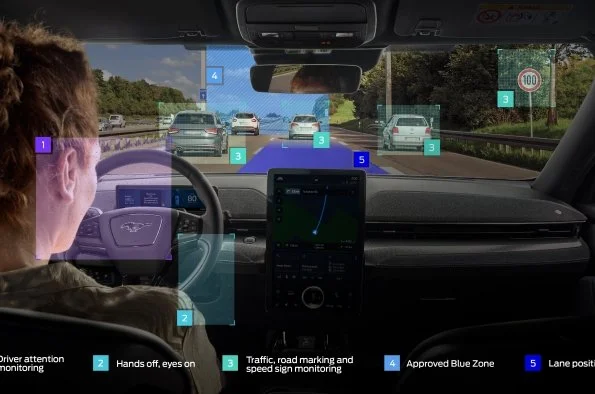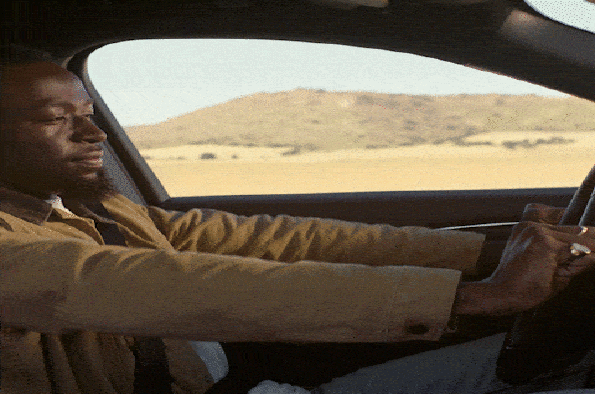Ford Hands-Free Technology. An exciting concept or terrifying prospect?
Hands-free driving. Are you brave enough to try it?
Ford has become the first carmaker to introduce “hands-off, eyes-on” advanced driver assistance technology approved for pre-mapped motorways in Great Britain. But, before you become complacent, picturing a lie down on the back seats and taking a nap while your car does all the work, think again.
Hands-free mode allows drivers on approved Blue Zone sections of the motorway to drive with their hands off the steering wheel, provided they continue to pay attention to the road ahead. All things considered, this will, hopefully, improve comfort levels during long drives, where the monotony of motorway driving can be problematic. This is all possible with a system that Ford has produced named BlueCruise.
So how does it work? BlueCruise monitors road markings, speed signs, and evolving traffic conditions to control steering, acceleration, braking, and lane positioning, as well as to maintain safe and consistent distances to vehicles ahead – right down to a complete halt in traffic jams.
In addition, sophisticated infrared camera technology continually checks driver attentiveness for safety and confidence. So if you’re feeling drowsy, the system will know.
Before transitioning to hands-free driving, BlueCruise-equipped vehicles will confirm that lane markings are visible, that the driver has their eyes on the road, and that other conditions are appropriate. The system uses animated cluster transitions featuring text and blue lighting cues to communicate that the feature is in hands-free mode, effective even for those with colour blindness.
Operating up to a maximum speed of 80mph (130km/h), BlueCruise uses a combination of radars and cameras to detect and track the position and speed of other vehicles on the road. A forward-facing camera detects lane markings and speed signs and, crucially, the system also uses an infrared driver-facing camera located below the instrument cluster to check the driver’s eye gaze and head pose – even when they are wearing sunglasses – and ensures that their attention remains focused on the road.
If the system detects that the driver is not paying attention to the road, warning messages are first displayed in the instrument cluster, followed by audible alerts, brake activations, and finally slowing of the vehicle while maintaining steering control. Similar actions are performed if the driver fails to place their hands back on the steering wheel when prompted to do so when leaving a Blue Zone.
It is already proving popular in North America, with drivers of 193,000 BlueCruise-equipped Ford and Lincoln vehicles having already driven more than 64 million hands-free miles in Canada and the US. Recently, BlueCruise was named the Consumer Report's Top Rated Active Driving Assistance System, in light of its success.
Now a green light for Ford BlueCruise technology from the UK’s Department for Transport means drivers of enabled Mustang Mach-E models can use ‘hands-off, eyes-on” driving technology on 2,300 miles (3,700 km) of pre-mapped motorways in England, Scotland, and Wales, designated as Blue Zones.
The safety of drivers, passengers, and other road users was central to development and approval. To assure this, Ford engineers undertook 100,000 miles of testing on European roads to validate the latest generation advanced driver assistance systems including BlueCruise and its supporting features, in addition to over 600,000 miles covered in the US and Canada before the system was introduced to those markets last year. Test drives in Great Britain helped prove its ability to handle circumstances that drivers encounter on an everyday basis, such as worn out lane marking, poor weather conditions, and roadworks.
Ford has delivered a watershed moment with the introduction of a Level 2 hands-free advanced driver assistance system with regulatory approval for use on the motorway network in Great Britain. It is the first system of its kind to be approved in Europe.
“It is great news that Ford has chosen us for the European launch of its BlueCruise technology, and I am delighted that this country is once more at the forefront of innovation,” said Jesse Norman, UK Transport Minister. “The latest advanced driver assistance systems make driving smoother and easier, but they can also help make roads safer by reducing the scope for driver error.”
Offering up to 372 miles (600km) pure electric driving range between charges and supported by Ford’s BlueOval Charge Network – Europe’s largest, with more than 450,000 chargers and growing – the Mustang Mach-E is among nine all-electric vehicles that Ford plans to offer in Europe by 2024. Ford plans to achieve zero emissions for all vehicle sales and carbon neutrality across its European footprint of facilities, logistics, and suppliers by 2035.
Ford expects BlueCruise to be activated in further European countries, as and when regulatory conditions permit and will roll out the system to further Ford vehicles in the coming years.
The Mustang Mach-E has already been reviewed well, with journalists praising it for its competitive price, compared to other SUVs on the market and Tesla-like acceleration. The SUV trend is here to stay and Ford’s effort to follow ever-changing regulations, whilst being innovative with the introduction of the BlueCruise technology is admirable.
How long before other carmakers follow suit? It’s hard to say, but the success of the BlueCruise by Ford will be closely watched in the next few years to see if it really can be viable across the UK, Europe, and the world.
Words: Mike Booth
Pictures: Ford Media


